Some Tips For Using A Few Words To Describe Voices:
Some tips for using a few words to describe voices:
1. Tone Words: Use tone words to convey the emotional quality of a voice. For example, you can describe a voice as "melodic," "soothing," "sharp," "gentle," or "commanding" to give readers a sense of the tone.
2. Pitch and Range: Mention the pitch and range of the voice. Is it "deep," "high-pitched," "raspy," or "full-bodied"? This can provide insight into the character's age, gender, or emotional state.
3. Accent and Diction: Describe the character's accent or diction briefly to give a sense of their background or cultural influences. For instance, "British-accented," "Southern drawl," or "formal."
4. Volume: Mention the volume of the voice, whether it's "whispering," "booming," "murmuring," or "hushed."
5. Quality: Use terms like "velvet," "silken," "gravelly," "honeyed," or "crisp" to convey the texture or quality of the voice.
6. Rate of Speech: Describe how fast or slow the character speaks, using words like "rapid," "slurred," "measured," or "rambling."
7. Mood or Emotion: Indicate the mood or emotion carried by the voice. For example, a "quivering" voice may convey fear or anxiety, while a "warm" voice may express comfort and reassurance.
8. Resonance: Describe the resonance of the voice, such as "echoing," "nasal," "booming," or "tinny."
9. Timbre: Mention the timbre of the voice, using words like "rich," "thin," "clear," or "smoky."
10. Cadence: Highlight the rhythm or cadence of speech with descriptors like "staccato," "lilting," "rhythmic," or "halting."
11. Intonation: Convey the character's intonation by saying their voice is "sarcastic," "apologetic," "confident," or "questioning."
12. Vocal Characteristics: If applicable, mention unique vocal characteristics, like a "lisp," "stutter," "drawl," or "accented 'r'."
More Posts from Lune-versatile and Others
How to Write Flashbacks More Effectively
Many of our favorite books include a flashback or two. They put the main story on pause and reveal things readers need to know, but how do authors decide when to use them?
These are a few tips I have about writing flashbacks effectively so you can feel confident about weaving them into your stories.
1. Create a Clear Trigger
When you walk into a kitchen and smell cookies baking in the oven, the smell might trigger a memory. Maybe it’s a happy memory of baking with your family or exchanging cookies with your friends during a holiday party.
You wouldn’t think about that memory in that exact moment without the sensory trigger. Flashbacks work the same way.
Give your character a specific trigger so it’s obvious they’re having a flashback. You shouldn’t only rely on making the flashback italicised or set off by page breaks. It will feel more expertly integrated if there’s a cause-and-effect relationship with the scene.
The trigger can also serve a purpose. Maybe your protagonist hears a car honking and has a flashback to their recent car accident. It could let the reader in on how the accident happened or what it was like. The sound being a trigger also shows readers that your protagonist hasn’t dealt with the emotional ramifications of that traumatic experience, so it’s still fresh and affecting how they live their life.
Remember, there should be a clear point of return when the flashback ends. It may not always be a second trigger, like your protagonist’s best friend calling their name. It could also be a sensory moment or experience within the flashback that makes the protagonist essentially wake up due to discomfort or becoming aware that it’s a memory.
2. Make It Plot Essential
Flashbacks are plot essential, meaning that they have to either do something for the reader or your protagonist (maybe both at the same time).
In the above example, reliving the car accident informs the reader about what the protagonist experienced before the story started.
A flashback about an ex-partner treated the protagonist in a previous relationship could motivate the protagonist to make a choice in their current relationship that they wouldn’t have otherwise. The choice propels the story in a new direction.
3. Get to the Point
It’s important to keep flashbacks brief. Readers are investing their time and energy into the story you’re telling, not the story that happened leading up to your plotline.
Extended flashbacks can also confuse readers. They may not understand when the flashback has ended, especially if the relived experience happened to your protagonist recently.
A few paragraphs to a page or two will likely be more than enough to get your flashback’s point across. If it runs longer, make a mental note to return to that particular scene when you’re in your editing phase.
-----
Flashbacks can be effective storytelling tools, but use these tips to avoid relying on them too much or in the wrong ways. If one doesn’t feel right even after you’ve worked through your initial edits, you can always take it out and work the information in by writing another present-day scene or conversation.
How do you turn a outline into chapters? Like how many chapters does a part of an outline turn into?
Turning an Outline Into Chapters
There's no method or template for how an outline translates into chapters. Instead, it's about breaking down the story into its natural parts.
Stories can be broken down into scenes. A scene is a mini-story that revolves around an important plot point in your story, or in other words a moment in your story that affects a main character's, their path, or the direction of the story. This moment could be:
-- a particular course of action taken by a main character -- an important conversation involving a main character -- an important event involving a main character -- a series of small related moments occurring in the same short period of time, the same place, involving the same character/s, revolving around a particular subject or theme, or from a particular character's POV.
Most scenes are (sometimes loosely) structured similarly to a story, having a small bit of introduction, an inciting incident, rising action, a dilemma, a climax, and a denouement. Like story in general, scenes should have a balance of exposition (explaining things), action (things happening), and dialogue (conversation).
Scenes end when the mini-story the scene is telling ends. Typically, this ending will also naturally shift toward a new plot point that takes place in a different time and/or different place, potentially with different characters.
Go through your summary and find the plot points and moments around which you can build your scenes, and divide them out into their scenes.
Chapters can be a single scene or a group of related scenes. If you have several scenes that take place during a similar time period (in the weeks before and during Halloween, for example), in a similar setting (the characters have traveled to Las Vegas for the week), or involving the same plot point (a heist that plays out over three scenes), these can be grouped together into one chapter. Typically, chapters are made up of one to three scenes.
Once you have your outline broken down into scenes, you can group the scenes into chapters.
Happy writing!
•••••••••••••••••••••••••••••••••
I’ve been writing seriously for over 30 years and love to share what I’ve learned. Have a writing question? My inbox is always open!
Learn more about WQA
Visit my Master List of Top Posts
Go to ko-fi.com/wqa to buy me coffee or see my commissions
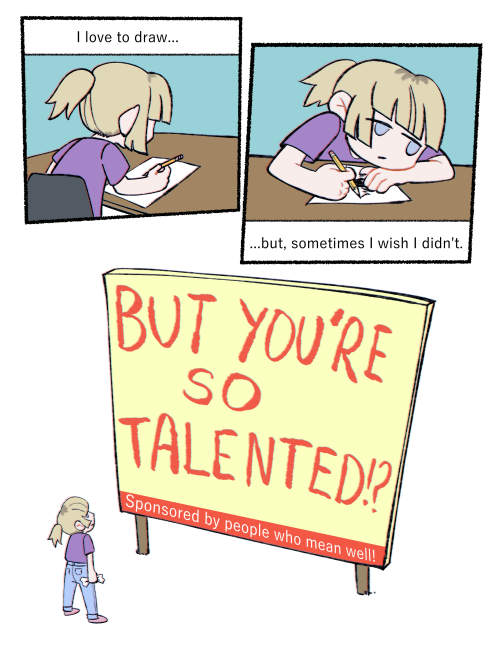
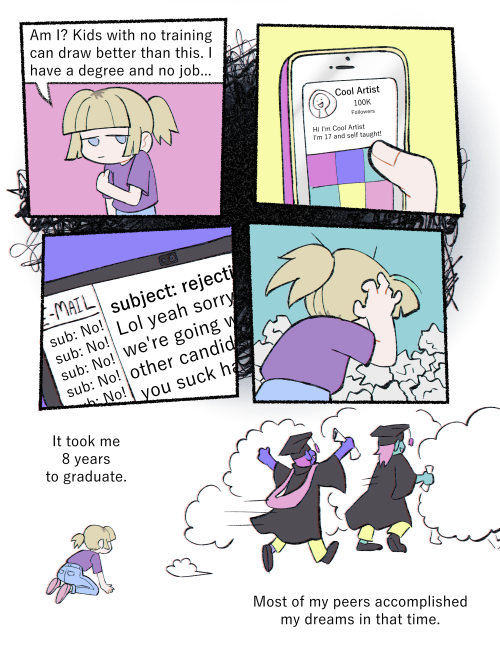

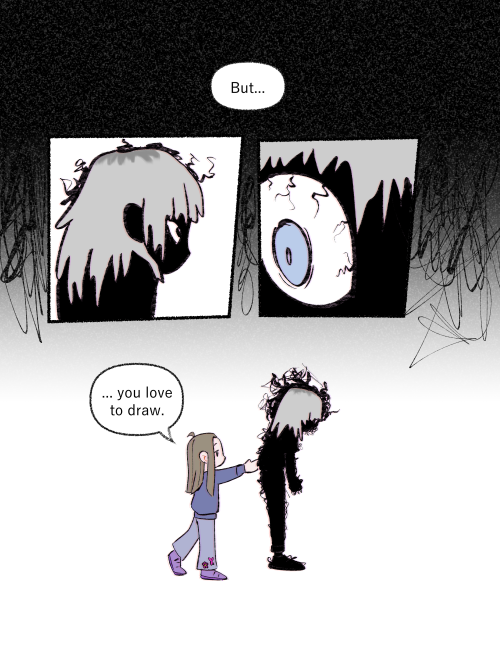
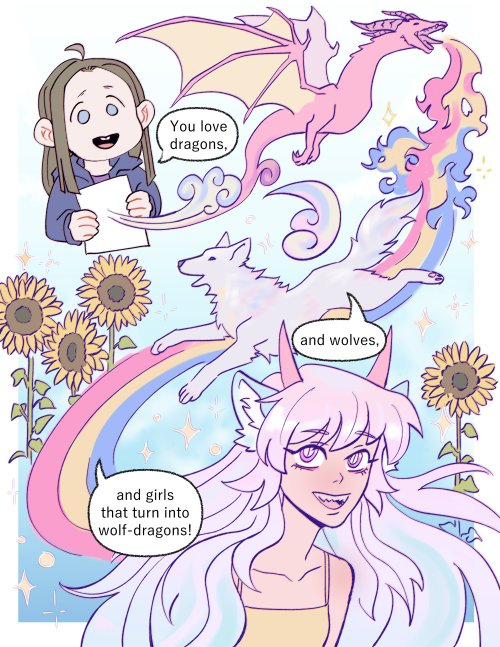
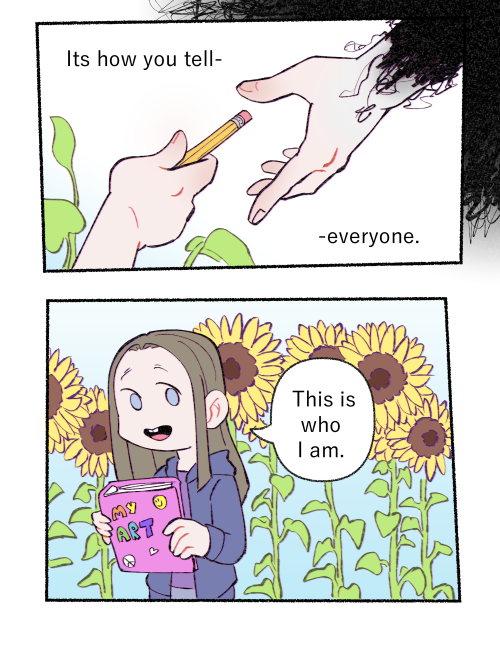

A comic to try and sort through some difficult feelings about being an artist and a reminder to not forget who you are.
How do I write a dream sequence that actually feels dreamy and not just confusing or random? I want it to make sense in the story but still have that weird, surreal vibe dreams have.
Before writing a dream sequence, ask yourself: Why is this dream important?
A strong dream sequence serves a narrative purpose. It either reveals something critical about the character or moves the plot forward. For example, it might:
Highlight a character’s inner conflict, such as self-doubt or guilt.
Offer insight into a character’s fears, desires, or memories.
Foreshadow future events.
Explore the story’s themes.
Present an epiphany or realisation that changes the narrative direction.
When you define the purpose of the dream, you give it meaning and ensure it doesn’t feel like a random, disconnected scene.
Vivid imagery and sensory details
Dreams are often hyper-real or surreal. To truly immerse readers, fill your sequences with vivid imagery. Describe not just what the character sees, but also what they hear, smell, and feel. For example:
The air might feel oppressively heavy, as if the character is moving through water.
Colours could be unnaturally bright or pulsing, creating a sense of unease or wonder.
Sounds may echo strangely, or voices may change tones mid-sentence.
Sensory details are your best friend when crafting dreams. They help you draw readers into the scene, making the dream feel almost tangible without being constrained to what is possible.
The power of symbolism
Dreams are often symbolic, reflecting a character’s subconscious thoughts and emotions. A dream sequence offers a fantastic opportunity to use metaphors and symbols to deepen your narrative. For instance:
A crumbling staircase may represent a character’s feelings of insecurity.
A recurring image, like a locked door, could hint at a secret the character is repressing.
Objects or people in the dream might represent aspects of the character’s personality or unresolved relationships.
By embedding symbols, you can subtly communicate deeper layers of meaning to your readers while building suspense without having to state things outright.
Heightened emotion
In dreams, emotions are often exaggerated. A minor embarrassment can swell into overwhelming shame, and a fleeting joy might feel like euphoria. Use this to your advantage to explore your character’s emotional state. For instance:
A character struggling with grief might dream of a loved one, only for them to disappear when approached.
A character racked with guilt could find themselves pursued by shadowy figures.
Striking a balance between disorientation and logic
Dreams are naturally disorienting because they don’t follow the logical flow of reality. You can introduce elements like sudden scene changes, nonsensical dialogue, or impossible physics to create a truly dreamlike experience. For example:
A character might start at a family dinner, only to inexplicably swimming in an ocean of stars.
A trusted friend might appear with the face of a stranger.
Despite the inherent chaos of dreams, your sequence should still have some degree of narrative coherence. A good rule of thumb is to maintain a logical thread that allows the dream to fulfil its narrative purpose, even if the details are illogical.
Establishing atmosphere
The tone and atmosphere of your dream sequence should align with its purpose. Focus on creating a specific emotional response:
For a nightmare, use eerie, oppressive details, like a pulsating fog or distorted, echoing voices.
For a whimsical dream, evoke wonder with surreal and magical details, such as floating landscapes and shimmering light.
Choose your atmosphere carefully to enhance the emotional impact of the scene.
Types of dream sequences to explore
There are many types of dream sequences, and each serves a unique purpose. Here are some of the most common:
Foreshadowing dreams: These hint at future events, creating suspense or intrigue.
Nightmares: These reveal a character’s fears or anxieties.
Fantasy dreams: These involve magical or surreal elements, and are often used to explore themes, symbols, or metaphors.
Recurring dreams: These underscore unresolved issues or patterns in a character’s life.
Lucid dreams: These allow the dreamer to be aware they’re dreaming and possibly influence the dream’s outcome.
Realisation dreams: These provide moments of clarity or epiphany for the character.
Internal conflict dreams: These visually showcase a character’s inner turmoil, providing a unique way to “show, not tell.”
Linked dreams: These connect two or more characters through shared dreamscapes.
Keep it brief and meaningful
Dream sequences should enhance your story, not derail it. While they offer a chance to be wildly creative, keep them concise and focused. Avoid overloading readers with too much detail or overly prolonged scenes. Your audience should leave the dream sequence full or curiosity, not overwhelmed.
Seamlessly transition in and out
Transitions are crucial for dream sequences. Start with subtle hints, like a sound, a sensation, or a surreal visual that cues readers into the shift from reality to dream. Similarly, exit the dream gracefully, creating a smooth return to the waking world. This ensures that readers are not jarred out of the story.
Writing tips for a dreamlike feel
Use narrative distance to create a floaty, disconnected feeling that mirrors the sensation of dreaming.
Experiment with stream-of-consciousness writing for portions of the dream to mimic the fluid and unpredictable nature of thoughts in sleep.
Pay attention to pacing. Dreams often feel both slow and rapid—a contradiction you can reflect by alternating between drawn-out descriptions and sudden, abrupt moments.
Dream sequences are a space where your imagination can truly run free while still serving the story’s deeper purpose. When done well, they are memorable and meaningful, and leave a lasting impact. It’s a technique well worth exploring.

TO WRITE CHAPTERS AND DRAFTS: “THE PAGES”
a highly customizable, simplistic but fancy googledoc for writing chapters and drafts, perfected for writers. a dark-mode version to please the eyes. to download / copy, go to file and click “make copy” to copy it to your gdrive.
features:
overview / introductory page with a section for ideas
dark-mode
table of contents for chapters
sub-headers to accompany main headers
bookmark system as navigation
aesthetically constructed layout to write your chapters in (2 columns)
please like / reblog if you’re using or interested in using it!
if you’re interested in more, check out the all-in-one gdoc “the book” here. dm me for requests.
World Building 101
World building! How many other hobbies or careers involve creating an entire world all your own? Not many.
There’s nothing quite like setting out to create your fictional world. Drawing maps, deciding which civilizations live where, throwing in crazy kinds of solar systems and vegetation if you’re really going all out… it can be a ton of fun.
However, one of the writer’s most exciting tasks is also one of their most intimidating.
On one hand: you get to build your own world. On the other hand… you have to build your own whole entire WORLD?! Where do you even start??
Well, you can start right here. Today I’m going to walk you through some basic pointers to get your world up and running.
World Building and World Building
Right off the bat, you should be aware that there are two kinds of world building. There’s the large-scale fantasy world building which I will be talking about today, and there is also world building that goes into other story genres.
Every writer is going to do some level of world-building, whether you’re painting a verbal picture of the lake your character goes to to get some peace of mind, pulling a reader into an important event and making them feel like they’re actually attending, or creating a whole new planet for your space pirate to fly to.
The Top 6
When you have a massive task ahead of you it’s always best to start by breaking it down. So, let’s take a look at the top 6 features you’re going to be focusing on when building your world.
WHO
Ask yourself: who lives in your world?Most likely there is a variety of species and races. Or, you could decide on a world where every creature is exactly alike — it is of course, your world.
Do the creatures of your planet have different cultures or are these homogeneous?
It will be easiest to start off with your main characters and work out from there. What is their species and race, and what does their culture look like?
For each species in your world, jot down the following:
Species name
Race names
Physical description
Language
Cultural notes
Special abilities
WHAT
Ask yourself: what social structures exist in your society? Again, start with your main characters and work out from there. For each species within your world, you’re going to need to determine how they manage their society.
What beliefs do they have? Are they religious, or more philosophical? Is there a divide between the two? What do their political structures look like? How strict are their laws?
You’ll want to consider trade and economy as well. Do they have a money system? A barter system?
You may not need to go too in depth with every single species in your world, but you’ll want a basic note or two about each in case it comes up in your writing.
For each species in your world, decide at least one point about each of the following:
Religion
Philosophies
Politics and laws
Economy
WHERE
Ask yourself: where does your species exist?Finally, we get to the physical world of your world building. What is the geography like? The biomes? Is your world bountiful with resources or is it a dying planet with species’ in desperate search of new sustenance?
For some writers, they will take years fleshing out the ‘where’ of their world, including the cosmos surrounding it. For others, a map with the basic locations of the story will suffice. It is up to you how in-depth you would like to go.
At the very least, you should outline one or two notes about each of the following:
Solar system (does your world exist near ours or is it completely fabricated?)
Geography (this one can be split per species — forest elves live in the woods, nymphs live near the sea, etc.)
Biomes (split by species region)
Resources (split by species region)
WHEN
Ask yourself: when do the events of your story occur?The story you are telling may be the main focus of your book, but what happened to lead up to it? What has your main character’s species and world been through that is causing the story to occur? Even if the events of the world do not impact your story much, they will have had at least some level of ripple effect that reflects on your characters’ day-to-day. Was this civilization a warring one and the story takes place in a broken society? Or, has their society reached its peak of enterprise?
For each region in your world, establish the following:
Founding events
Defining events
Recent events
(if relevant) Future events
WHY
Ask yourself: why do the species in your world behave as they do?The why of your story will tie in with many of the previous points you’ve outlined, but it gets more to the point in a way that can directly apply to your story and characters. Why are things happening as they are today? What evolution did this society go through? Do they share common goals now or are your characters going against the grain of their people? What conflicts exist in this world, and is your main character involved in those conflicts or attempting to avoid involvement?
A few pertinent notes to take per species would be:
Social evolution
Societal goals
Societal conflicts
HOW
Ask yourself: how do the species in your world solve problems? In the category of ‘who’, you will have outlined your main characters’ abilities. These could be magical or technological or maybe they are super strong, or super smart. Now, you can get deeper into the magical or technological systems of your world. Start with your main characters and work outwards. Is everyone magical here? Do different species and races have different abilities? Is there a human or human-related race, and at what point are they at with their technology?
Figure out the following (for each species and race if applicable):
Magic abilities
Technological advancements
Scientific knowledge
Militaristic power
The World is yours: Command it
An author with a strong command of the world they are writing within will have at their fingertips an endless landscape of possibility. Look to authors such as J.R.R. Tokien or George R.R. Martin — it’s no wonder their works are so successful. They perfectly encapsulate what fantasy readers are looking for in a novel: escapism. The worlds don’t need to be pretty, they need to be fully formed; realistic in their mysticism.
World-building can seem like a lot of work, and it is. But do it bit by bit, and try to keep it fun. Don’t sit down in one day expecting to create your whole world. It’ll take time. But that time spent will be well worth it in the end!
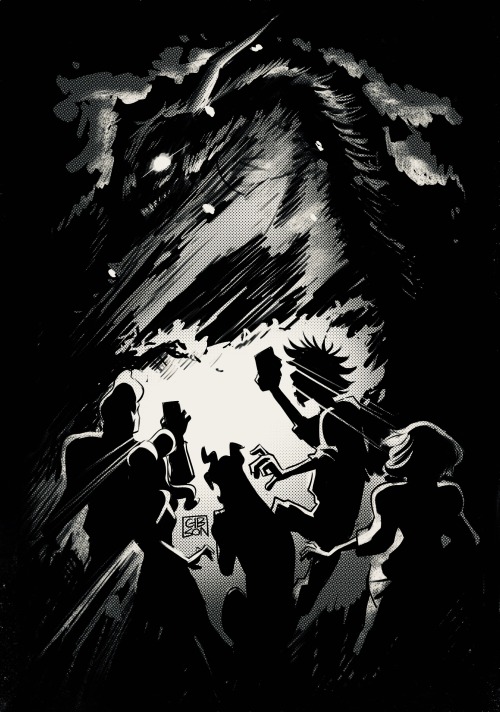

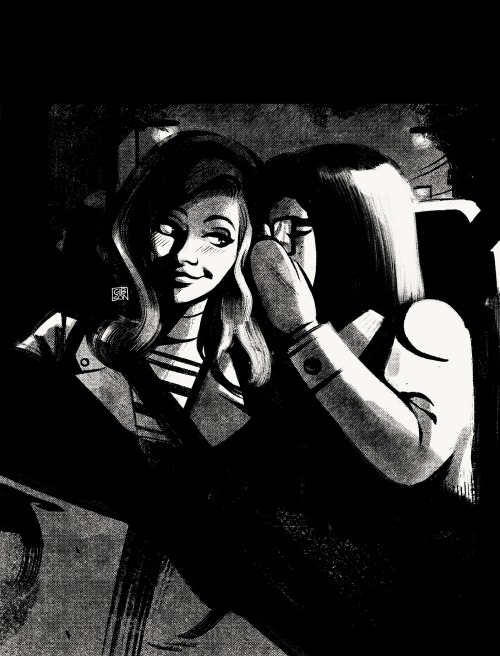


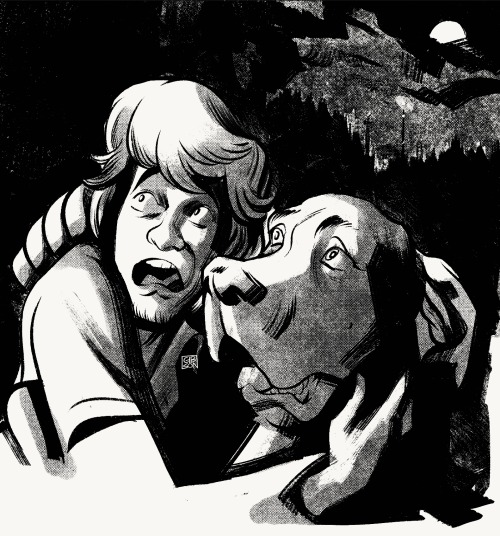
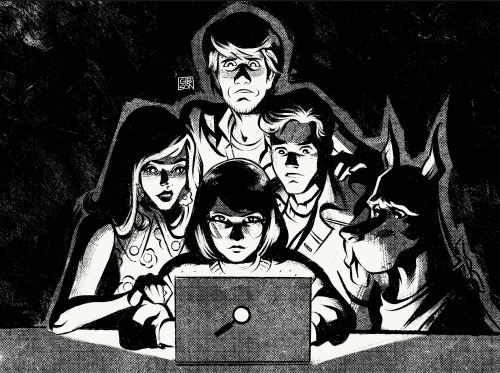
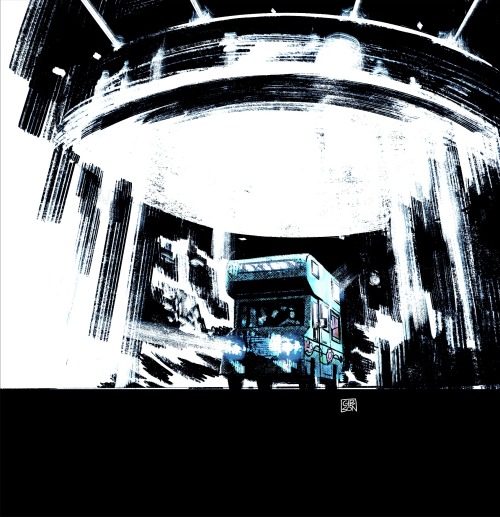
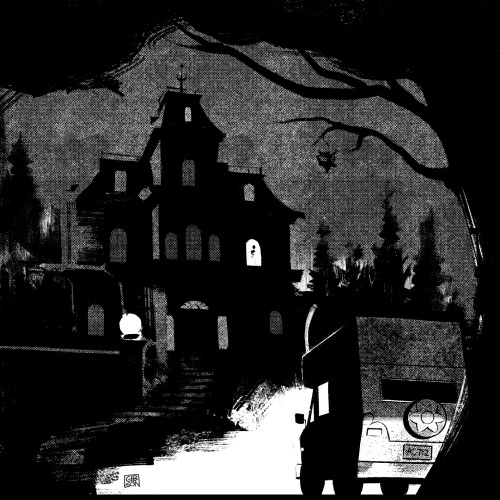
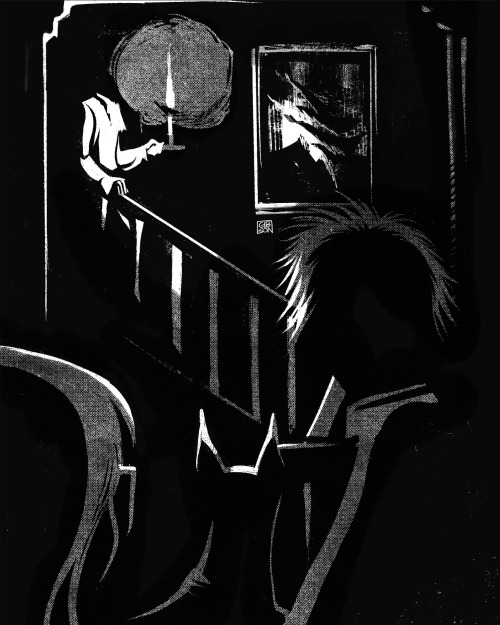
Mystery Inctober, #1-10
instagram | storenvy | portfolio | twitter
A Few Tips On Writing Chapters
Give each chapter a descriptive title.
Especially if you find yourself at sea when deciding how exactly to chop your story into pieces. Even if you don’t want to use chapter titles in your final draft, they’re of enormous use when you’re still figuring out exactly what the shape of your story is. By giving your chapter a descriptive title, you’re giving your chapter a focus and a particular story for your chapter to tell.
Make sure each chapter has its own self contained narrative arc.
This is not to say that every novel must be episodic, but that each section should have its own beginning, middle, and end. It should have set up, build up, and resolution. It should ask a question an implicit question at the beginning and provide a slightly more explicit answer at the end.
Example: one chapter in my book is just 500 words. Two new characters drive into town, get out of a car, knock on a door, and they say their names. The beginning is the introduction of the mystery of these characters. It’s the question “who are these people?” As they drive, you see them and where they are going, which builds towards the answer. As a resolution, you get their names.
You wouldn’t call this a “short story” by any means, but it does have a firm beginning, middle, end. It is a contained unit.
A chapter break can–and sometimes should–come in the middle of a scene.
Twists and cliffhangers can appear at the end of novels, so it would be silly to say you couldn’t end a chapter that way, too. Cliffhangers and twists are usually both a result of other plot points, and the cause of a new problem. Narratively, they function both as the ending of one thing and the beginning of another, so they make for great chapter breaks. Separating the scene at a cliffhanger is often better/cleaner than lumping the entire scene into one chapter.
Example: Alex is warned to stay away from a dangerous cliff. Alex gets adventurous and wanders toward cliff. Alex falls off of cliff. Beginning. Middle. End.
Alex is actually hanging from cliff! Alex figures out a way to get back to solid ground, struggles. Alex makes it back to solid ground. Beginning. Middle. End.
You want your readers to “just one more chapter!” their way through your book. Stuffing moments of high tension into the middle of chapters that resolve neatly won’t keep them turning pages.
Always end your chapters on a point of intrigue.
Using points of tension to bookend chapters is important because chapter endings are usually where readers put a book down during a reading session. They’re very naturally places to close the cover and walk away.
As a writer, you don’t want this. You absolutely don’t want to give your reader great places to put the book down, because you need them to pick the book up again as soon as possible. Not the next day, or the next week, (or never), but while they have a spare minute during their commute, or during their lunch break, or under their desk in class.
You want to encourage this by taking that perfectly natural endpoint, that place they expect to be able to put the book down, and forcing them to take even a tiny peak at the next chapter.
This doesn’t mean ending every chapter on a verifiable cliffhanger, but there has to be something. A character can solve a mystery. A new character can appear. There can be a moment of irony. A new idea. Just so long as it’s something that will make the reader think “I need to know what happens next.”
Got these from Pinterest, idk how to credit but these are not mine.



u know what, even if my writing isnt the BEST, i still made it all on my own. like there was a blank word doc and i filled it up with my own words, my own story. i took what was in my head and i made it a real thing. idk i feel like that alone is something to be proud of.
-
 nthsnowflake liked this · 4 days ago
nthsnowflake liked this · 4 days ago -
 boomstab-papa reblogged this · 5 days ago
boomstab-papa reblogged this · 5 days ago -
 d-lynx liked this · 5 days ago
d-lynx liked this · 5 days ago -
 sheepheadfred reblogged this · 5 days ago
sheepheadfred reblogged this · 5 days ago -
 antihell liked this · 1 week ago
antihell liked this · 1 week ago -
 russetfoxfur reblogged this · 2 weeks ago
russetfoxfur reblogged this · 2 weeks ago -
 analogbasilisk reblogged this · 2 weeks ago
analogbasilisk reblogged this · 2 weeks ago -
 princessprepared reblogged this · 2 weeks ago
princessprepared reblogged this · 2 weeks ago -
 ems-haunted-library reblogged this · 2 weeks ago
ems-haunted-library reblogged this · 2 weeks ago -
 chaosinsp reblogged this · 2 weeks ago
chaosinsp reblogged this · 2 weeks ago -
 frog-squeaks liked this · 2 weeks ago
frog-squeaks liked this · 2 weeks ago -
 elainson liked this · 2 weeks ago
elainson liked this · 2 weeks ago -
 watergeus reblogged this · 3 weeks ago
watergeus reblogged this · 3 weeks ago -
 fluteofinfinitemelody reblogged this · 3 weeks ago
fluteofinfinitemelody reblogged this · 3 weeks ago -
 semestanyamin liked this · 3 weeks ago
semestanyamin liked this · 3 weeks ago -
 meance-in-theory liked this · 3 weeks ago
meance-in-theory liked this · 3 weeks ago -
 cherishmartell reblogged this · 3 weeks ago
cherishmartell reblogged this · 3 weeks ago -
 teal-blue-genesis liked this · 1 month ago
teal-blue-genesis liked this · 1 month ago -
 repressedbastard liked this · 1 month ago
repressedbastard liked this · 1 month ago -
 kaygirl6567 liked this · 1 month ago
kaygirl6567 liked this · 1 month ago -
 smorallow liked this · 1 month ago
smorallow liked this · 1 month ago -
 todomemolesta18 reblogged this · 1 month ago
todomemolesta18 reblogged this · 1 month ago -
 it-is-what-it-is-what-it-is reblogged this · 1 month ago
it-is-what-it-is-what-it-is reblogged this · 1 month ago -
 legendaryblondze reblogged this · 1 month ago
legendaryblondze reblogged this · 1 month ago -
 legendzjagz liked this · 1 month ago
legendzjagz liked this · 1 month ago -
 elizabettown liked this · 1 month ago
elizabettown liked this · 1 month ago -
 lost-on-stage reblogged this · 1 month ago
lost-on-stage reblogged this · 1 month ago -
 lost-on-stage liked this · 1 month ago
lost-on-stage liked this · 1 month ago -
 owlcat-art liked this · 1 month ago
owlcat-art liked this · 1 month ago -
 vverago reblogged this · 1 month ago
vverago reblogged this · 1 month ago -
 ilikedarkrai liked this · 1 month ago
ilikedarkrai liked this · 1 month ago -
 xx-leech liked this · 1 month ago
xx-leech liked this · 1 month ago -
 daylinlavellan reblogged this · 1 month ago
daylinlavellan reblogged this · 1 month ago -
 daylinlavellan liked this · 1 month ago
daylinlavellan liked this · 1 month ago -
 cosmiclv reblogged this · 2 months ago
cosmiclv reblogged this · 2 months ago -
 cxnsdellaj liked this · 2 months ago
cxnsdellaj liked this · 2 months ago -
 queenofthursday6599-blog reblogged this · 2 months ago
queenofthursday6599-blog reblogged this · 2 months ago -
 doomednarrative liked this · 2 months ago
doomednarrative liked this · 2 months ago -
 wander-over-the-words reblogged this · 2 months ago
wander-over-the-words reblogged this · 2 months ago -
 sterbendehund liked this · 2 months ago
sterbendehund liked this · 2 months ago -
 beloveddame liked this · 2 months ago
beloveddame liked this · 2 months ago -
 anotherlesbiandad reblogged this · 2 months ago
anotherlesbiandad reblogged this · 2 months ago -
 bts-roses liked this · 2 months ago
bts-roses liked this · 2 months ago -
 probablywatchingsitcoms liked this · 2 months ago
probablywatchingsitcoms liked this · 2 months ago -
 mameeta liked this · 2 months ago
mameeta liked this · 2 months ago
